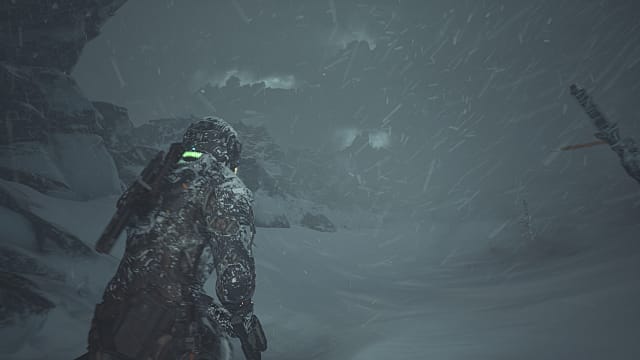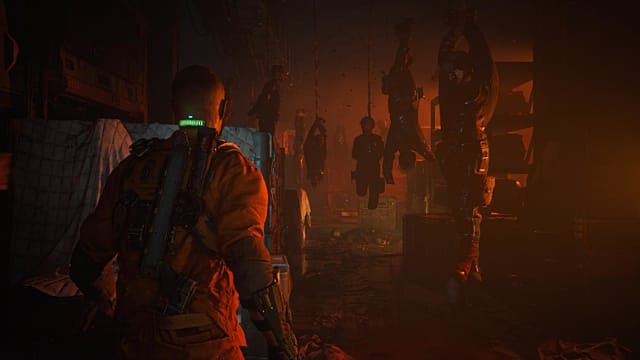When something new evokes our memories and nostalgia from a particular source, it puts unreasonable expectations on that new thing’s shoulders. I don’t want to burden The Callisto Protocol with the weight of being a continuation of the Dead Space franchise.
In many ways, the latest space horror game from ex-EA Creative Director Glen Schofield, now CEO at developer Striking Distance Studios, is at least trying out as many new ideas as it’s ripping off. Unfortunately, The Callisto Protocol lacks the follow-through to execute any of its ideas in any particularly interesting ways.
In The Callisto Protocol, you play as Jacob Lee, a space-trucker-type who gets mixed up in a prison break on Jupiter’s moon of Callisto. In this third-person action horror title, you spend most of your time trying to escape while uncovering the shallow mysteries of a biophage outbreak.
It’s all boilerplate stuff. The story itself is a means to put you in a creepy environment full of monsters who want to destroy you in the goriest ways imaginable. Through this lens, The Callisto Protocol shares a beating, bloody heart with Dead Space, where many elements of the presentation and UI also take strong influence from Schofield’s earlier title. But The Callisto Protocol makes its mission statement clear from the first encounter. This is a game about intense and punishing melee combat.
In my experience, this led to a frustrating and confusing first couple of hours with the game (which only averages about 10 hours or so in total). In spending time with the unique combat mechanics, however, I found there to be a satisfying and intentional flow to the encounters.
Dodging and blocking in The Callisto Protocol is simple. As long as you are holding down the left stick in a direction when an enemy attacks, you will dodge (or block if you hold the stick back toward you) the attack, regardless of direction or timing. To avoid successive attacks, you must push the stick in the opposite direction, which creates a defensive circus of ducking and weaving.
It is a cinematic take on close-quarters combat that leaves the monsters open for counterattacks from your firearms, where a reticle will appear after a quick combo, allowing you to take them down quickly. This action feels good, and the kills are satisfying. On paper, this Punch-Out!! style combat could be great for some epic duel-style encounters.
The problem with The Callisto Protocol‘s combat is twofold. The entire melee system is built around facing just one enemy at a time. In the later chapters, things get messy and chaotic when facing rooms full of enemies. The second issue is that not much changes. The tactics you learn in the first encounter are about as complex as the melee combat gets.
The Callisto Protocol also features a handful of guns that are mostly useful in tandem with these melee combos. Once you get to the game’s back half, you have a standard Resident Evil loadout of a handful of shotguns, pistols, and a machine gun. Some additions to the basic combat include ridiculously easy one-hit takedown stealth sections and enemies that require you quickly take them down lest they transform and grow more powerful. None of these variations on the core gameplay feel welcome; by the end, each repetitive task wears thin.
Repetition is the Achilles heel of The Callisto Protocol. From dozens of identical combat encounters to a seemingly endless amount of shimmying through narrow crevices, everything The Callisto Protocol does, it makes sure to repeat. The most egregious example is a late-game boss that, after you defeat it once, appears three more times in the span of the game’s final hours.
This boss — a frustrating one in the first place — is just one of many small flaws that hamper The Callisto Protocol. Inconsistent checkpoints run amok. Occasionally, being stuck on a section and repeatedly loading a checkpoint led to item pickups disappearing entirely, shifting the difficulty further from my favor. This was, thankfully, the only major game-breaking glitch encountered in my playthrough, though a GameSkinny editor ran into issues that wouldn’t allow him to use health packs or switch weapons in one boss fight.
The UI, as well, is clunky and difficult to navigate, taking from Dead Space but making it worse. The camera is so zoomed in on protagonist Jacob Lee that there is a level of clunky claustrophobia that permeates the entire game. Plenty of times, when you pick up items from the ground, you are just mashing the pickup button because you can’t see what you are picking up. Which, of course, leads to more time doing inventory management in the terrible menus.
I found myself switching between the game’s medium and easy difficulties throughout my time with The Callisto Protocol, and frankly, I often forgot which setting the game was turned to. It felt that aside from letting you take a few more hits, the difficulty options do very little to fix the spikes in balancing that plague the game. Despite that, there is a solid number of accessibility options on offer, a surprising positive in a game that actively feels untested by any human players in parts.
The other positives can all be credited to The Callisto Protocol‘s atmosphere. The game is quite possibly the most technically impressive game I’ve seen run on a Series X. Graphics mode in 4K highlights the absolutely stunning lighting and visual effects. Turning on performance mode ensures a smooth 60 FPS, and the game will still be gorgeous, albeit in a lower resolution.
The art direction in The Callisto Protocol isn’t doing anything groundbreaking. The enemy designs don’t make much of an impression. Still, I can’t help but admit the atmosphere and production values drove me through the game more than any of its narrative or systems. Black Iron prison might not have been the most interesting place to explore, but it was a damn good-looking one.
The Callisto Protocol Review — The Bottom Line
Pros
- Technically gorgeous graphics.
- Fundamentals of combat are great for one-on-one encounters.
Cons
- Combat breaks under the weight of multiple enemies and boss fights.
- Gameplay is repetitive and doesn’t evolve in any significant ways.
- A cliche story told in a boring setting.
- Plagued by little bits of bad design like inconsistent checkpoints and unbalanced difficulty settings.
Visually, The Callisto Protocol is one of the only games for the PS5 and Xbox Series X that feels like a next-generation game. But that ambition has clearly come at a cost. For all its bells and whistles, The Callisto Protocol isn’t doing much of anything new with its story or design. It’s not just a Dead Space imitator, but it does manage to take a lot of the ideas from earlier action horror games and execute them half as well.
Alongside myriad factors and the fact that New Game Plus and Hardcore modes — staple features of the genre — aren’t coming until next year is evidence that The Callisto Protocol should have been given more time to have a smoother, fully-featured launch.
[Note: Krafton provided the copy of The Callisto Protocol used for this review.]





